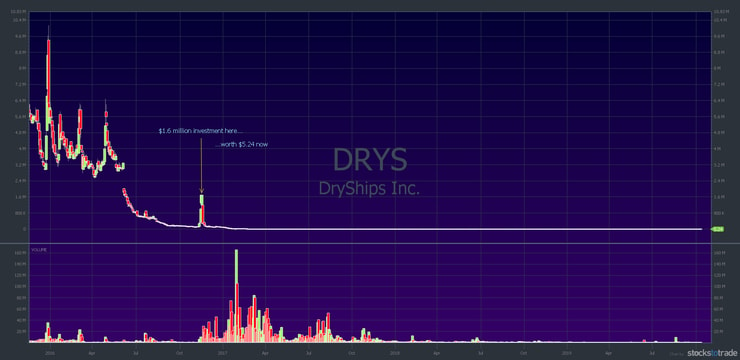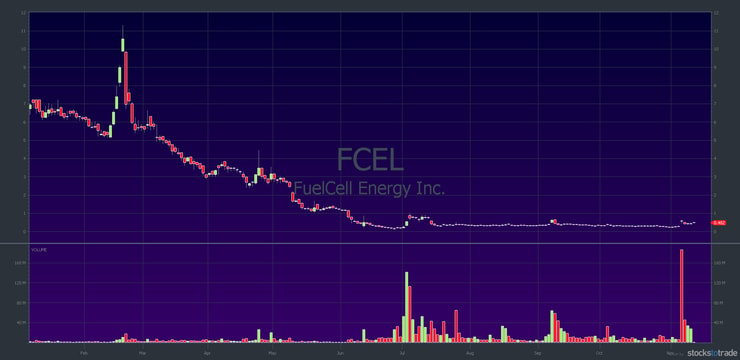In today’s post, I’ll share a case study on toxic financing featuring FuelCell Energy, Inc (NASDAQ: FCEL). Welcome to the dark side of penny stocks.
For the last two years, I’ve been primarily a long-biased trader who trades with a small account.
Why do I trade with a small account?
I’ve found that trading with a small account makes it easier for my students to learn. Rather than watching me trade with hundreds of thousands of dollars, I trade with an account that’s similar in size to theirs.
I want to prove it’s possible to be profitable with a small account and also teach my students in the Trading Challenge how to be consistently profitable.
Table of Contents
My Trading Style
Why am I a long-biased penny stock trader?
Recently, I discussed the growing trend of newbie short-sellers and short-selling chatrooms. I’m not saying new traders can’t make money shorting, but they’re utterly unprepared for the volatile penny stock market.
A couple of weeks ago, I provided two in-depth blog posts about the XNET short squeeze and why short squeezes are growing in frequency, expressing the difficulty of shorting right now.
Again, let me emphasize: Longing penny stocks isn’t a walk in the park. Over 90% of people fail to trade penny stocks profitably. However, my top students have defied the odds and consistently make money trading penny stocks.
Buying penny stocks has a lousy reputation in large institutions on Wall Street, which has scared many people away from this profitable niche. They’re the worst of the worst companies. After all, penny stocks are penny stocks for a reason! But the problem isn’t penny stocks. People aren’t aware of the scummy practices penny stock companies and their promoters use on a daily basis.
The Dark Side of Buying Penny Stocks
I’ve talked about stock dilution and toxic financing in a ton of video lessons and blog posts. There’s nothing wrong with dilution. Companies do it all the time. Large blue-chip companies like Apple continuously issue new bonds and other notes to fund their research and development.
But penny stocks don’t have the same financing options as large companies. So, they‘re forced into toxic deals that dilute shareholders to avoid bankruptcy.
All companies are out for themselves. They’ll do anything and everything to stay alive, including dump millions of shares on your positions to raise money.
Penny Stock Toxic Financing
The underlying reason for most penny stock runs is to help a company justify an offering with a financer. During this deadly cycle of dumping shares on retail investors, companies often run out of ways to finance their operations, leading to toxic deal structures.
The best example of this toxic stock dilution happened with DryShips Inc. (NASDAQ: DRYS). During the autumn of 2016, DRYS went on an impressive multiday run from $4 to a high of $100. This massive short squeeze was one of the largest I’ve ever seen, and many of my students capitalized on the insane move.
Since 2016, the company has undergone numerous reverse splits and continuously issued new forms of toxic financing to help fund its operations. DryShips’s financing forced millions of shares into the public market and caused the stock to fall in price dramatically.
Regardless of a catalyst, news event, or the amount of volume traded on any given day, the structure of the finance deals didn’t allow the stock to spike a considerable amount. It’s a sad thing to see and one of the main reasons penny stocks have such a bad reputation.
Many people invested in DRYS, but over the years, the dilution caused any investment in the company to be worthless.
Adjusted for all the reverse stock splits, here’s the current DRYS chart…

Look at the dilutive downtrend. After factoring in reverse splits, if someone invested $1.6 million at the peak of the November 2016 run, those shares would currently be worth only $5.24 today. (Hint: click on the chart to view full-size in a new browser tab.)
It’s no wonder why penny stocks are terrifying to the outside investor who’s uneducated!
If you’re looking to start your education but don’t know where to begin, my FREE guide to penny stocks is a great resource for new traders.
FCEL’s Dark Side
A current example of toxic stock dilution is occurring with FuelCell Energy, Inc (NASDAQ: FCEL).
Since the beginning of 2019, the company has undergone multiple reverse stock splits and continues to dilute into shareholders.

Every time the stock spikes, the company unloads its previous offerings, selling millions of shares onto retail investors. Information about the offerings is challenging to find and requires an understanding of SEC filings.
SEC filings are extremely difficult to read because they’re convoluted with business and lawyer jargon to hide the terrible dilution occurring behind the scenes. (Get my Read SEC Filings DVD here. My first millionaire student, Michael Goode, and I go into detail about our research methods. This must-have DVD simplifies the process of poring over all sorts of SEC filings. And … it pulls back the veil on toxic financing.)
Because of the shady practices by financing firms and penny stock companies, newbies often buy stocks like FCEL when they begin to spike or when a new press release comes out. Sadly, time and time again, the company will sell its offering shares into the spike, causing the stock to dump and newbies to lose money.
The toxic stock dilution practices are legal because they’re fully disclosed in the SEC filings. This dark side of penny stocks is rarely discussed and will never go away. For many companies, it’s their only hope of survival.
The only thing people can do is educate and protect themselves from the dilution. From a long-biased standpoint, traders should avoid stocks like FCEL and DRYS once they become massively dilutive.
I’m proud to say that many of my students did a great job navigating FCEL and their offers the past several weeks.
Shorting the Dark Side
The dilution throughout penny stocks is one of the biggest draws for new short sellers. However, these newbies don’t understand the foundations of trading and can’t appropriately trade a dilutive company like FCEL.
Michael Hudson, Profit.ly user Huddie, is one of my top students. To date, he reports profiting approximately a quarter of a million dollars primarily from short selling stocks. Huddie invested in his education and studied for many years. As a result, he understood FCEL was a great shorting opportunity.
He published a video on Profit.ly discussing how he took advantage of FCEL’s toxic financing. You can watch it here.
Huddie explains in his video lesson how he formed a trading plan around the FCEL dilution and used his live FCEL trade to show students how to take good entries and exits.
Thanks to the lessons from the Trading Challenge, he waited for the proper time to short FCEL and capitalized on the dump.
[Please note Huddie’s results are not typical. He has exceptional knowledge and skills that he’s developed with time and dedication. Most traders lose money. Trading is risky. Do your due diligence and never risk more than you can afford.]
The Truth About Shady Penny Stocks
Penny stocks are a unique niche in the stock market because they’re some of the most highly volatile and scummy companies on the planet — but they can offer incredible trading opportunities.
I always tell my students to invest in their education first. The uneducated people are the ones buying DRYS or FCEL and getting dumped on from their shady offerings. My students understand that not all penny stocks are worth playing.
One of the first lessons from my Trading Challenge is to look at a daily chart and see if a stock has ever tried to run before. In cases like FCEL, it’s clear there’s something fundamentally wrong with the company.
FCEL trended down for all of 2019 with many failed spikes. The failed spikes are a huge red flag for long-biased traders but can be an excellent opportunity for short sellers like Huddie.
The lack of information and shady behavior of penny stock companies can help my students get ahead. I don’t want toxic financing or other misleading practices to end because they potentially only help my students. While there are no guarantees in the market, ever, some of us are all about these situations, under the right circumstances.
My only hope is you take trading seriously and will educate yourself to avoid companies willing to dump millions of shares onto their shareholders.
Recent Tweets, Comments, and Trades from Students
FCEL has tried to spike many times, but my students were prepared! Many of them followed Huddie’s example and profited on the short side.
From the Trading Challenge Chat Room
November 6:
1:35 PM jobeauthement: $fcel going back to the gutter where it belongs.
3:08 PM markcroock: float seems like its a few billion lol on $FCEL.
November 7:
11:13 AM markcroock: $FCEL will try give it all day for fade to new lows.
12:47PM Jackaroo: covered $FCEL .43, from .50. Just a small gain because I used small position size, but good practice.
More Breaking News
- Transocean Ltd Sets Sail: Is It Time to Buy?
- Bit Digital Expands: What’s Next in AI?
- Impinj Stock Surges: Investment Opportunity?
More Comments from the TimAlerts Chat Room
November 6:
10:00 AM MichaelGoode → SSAK: $FCEL having convertibles outstanding and an ATM certainly don’t help it go up.
1:42 PM SatelliteIncomeUnlimited: $FCEL climbing again, but it’s risky for a couple of pennies per share at the most right now.
November 7:
1:22 PM CKP111: when you buy the dip and it just continuously dipping lol that’s $BNGO. It reminds me of $FCEL.
1:42 PM MichaelGoode: $FCEL broke yesterday’s low.
What’s your opinion on trashy penny stocks? Comment below — I love to hear the opinions of my readers!












Leave a reply